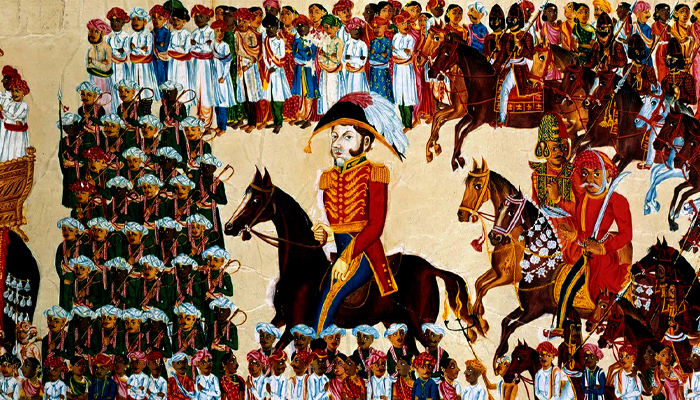It is true that before British rule, India was starting to fall behind other parts of the world – but many of the arguments defending the Raj are based on serious misconceptions about India’s past, imperialism and history itself.
The British empire in India was in effect established at the Battle of Plassey on 23 June 1757. The battle was swift, beginning at dawn and ending close to sunset. It was a normal monsoon day, with occasional rain in the mango groves at the town of Plassey, which is between Calcutta, where the British were based, and Murshidabad, the capital of the kingdom of Bengal. It was in those mango groves that the British forces faced the Nawab Siraj-ud-Doula’s army and convincingly defeated it.
During my days as a student at a progressive school in West Bengal in the 1940s, these questions came into our discussion constantly. They remain important even today, not least because the British empire is often invoked in discussions about successful global governance. It has also been invoked to try to persuade the US to acknowledge its role as the pre-eminent imperial power in the world today: “Should the United States seek to shed – or to shoulder – the imperial load it has inherited?” the historian Niall Ferguson has asked. It is certainly an interesting question, and Ferguson is right to argue that it cannot be answered without an understanding of how the British empire rose and fell – and what it managed to do.
Arguing about all this at Santiniketan school, which had been established by Rabindranath Tagore some decades earlier, we were bothered by a difficult methodological question. How could we think about what India would have been like in the 1940s had British rule not occurred at all?
The frequent temptation to compare India in 1757 (when British rule was beginning) with India in 1947 (when the British were leaving) would tell us very little, because in the absence of British rule, India would of course not have remained the same as it was at the time of Plassey. The country would not have stood still had the British conquest not occurred. But how do we answer the question about what difference was made by British rule?
To illustrate the relevance of such an “alternative history”, we may consider another case – one with a potential imperial conquest that did not in fact occur. Let’s think about Commodore Matthew Perry of the US navy, who steamed into the bay of Edo in Japan in 1853 with four warships. Now consider the possibility that Perry was not merely making a show of American strength (as was in fact the case), but was instead the advance guard of an American conquest of Japan, establishing a new American empire in the land of the rising sun, rather as Robert Clive did in India. If we were to assess the achievements of the supposed American rule of Japan through the simple device of comparing Japan before that imperial conquest in 1853 with Japan after the American domination ended, whenever that might be, and attribute all the differences to the effects of the American empire, we would miss all the contributions of the Meiji restoration from 1868 onwards, and of other globalising changes that were going on. Japan did not stand still; nor would India have done so.
While we can see what actually happened in Japan under Meiji rule, it is extremely hard to guess with any confidence what course the history of the Indian subcontinent would have taken had the British conquest not occurred. Would India have moved, like Japan, towards modernisation in an increasingly globalising world, or would it have remained resistant to change, like Afghanistan, or would it have hastened slowly, like Thailand?
These are impossibly difficult questions to answer. And yet, even without real alternative historical scenarios, there are some limited questions that can be answered, which may contribute to an intelligent understanding of the role that British rule played in India. We can ask: what were the challenges that India faced at the time of the British conquest, and what happened in those critical areas during the British rule?
British rule ended nearly 200 years later with Jawaharlal Nehru’s famous speech on India’s “tryst with destiny” at midnight on 14 August 1947. Two hundred years is a long time. What did the British achieve in India, and what did they fail to accomplish?
There was surely a need for major changes in a rather chaotic and institutionally backward India. To recognise the need for change in India in the mid-18th century does not require us to ignore – as many Indian super-nationalists fear – the great achievements in India’s past, with its extraordinary history of accomplishments in philosophy, mathematics, literature, arts, architecture, music, medicine, linguistics and astronomy. India had also achieved considerable success in building a thriving economy with flourishing trade and commerce well before the colonial period – the economic wealth of India was amply acknowledged by British observers such as Adam Smith.
The fact is, nevertheless, that even with those achievements, in the mid-18th century India had in many ways fallen well behind what was being achieved in Europe. The exact nature and significance of this backwardness were frequent subjects of lively debates in the evenings at my school.
An insightful essay on India by Karl Marx particularly engaged the attention of some of us. Writing in 1853, Marx pointed to the constructive role of British rule in India, on the grounds that India needed some radical re-examination and self-scrutiny. And Britain did indeed serve as India’s primary western contact, particularly in the course of the 19th century. The importance of this influence would be hard to neglect. The indigenous globalised culture that was slowly emerging in India was deeply indebted not only to British writing, but also to books and articles in other – that is non-English – European languages that became known in India through the British.
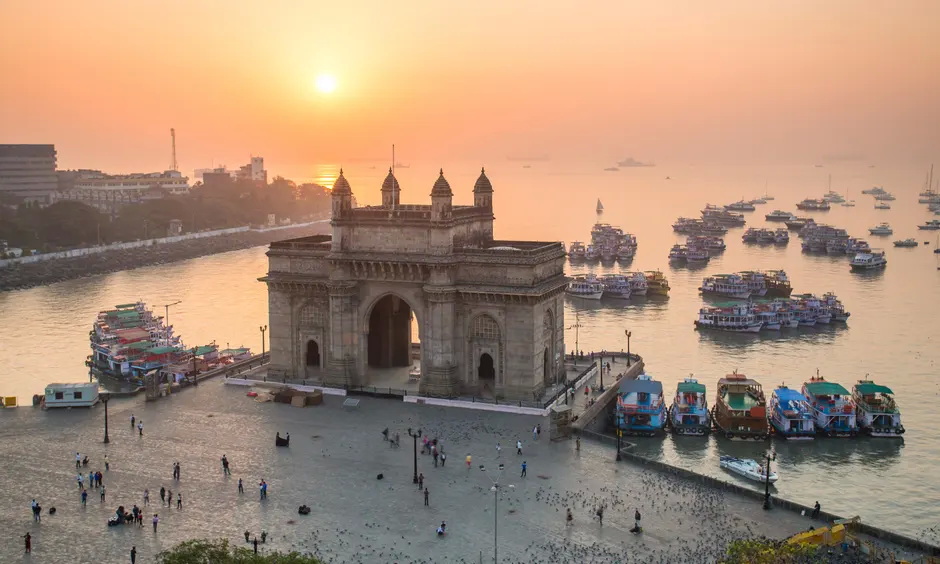
Figures such as the Calcutta philosopher Ram Mohan Roy, born in 1772, were influenced not only by traditional knowledge of Sanskrit, Arabic and Persian texts, but also by the growing familiarity with English writings. After Roy, in Bengal itself there were also Ishwar Chandra Vidyasagar, Madhusudan Dutta and several generations of Tagores and their followers who were re-examining the India they had inherited in the light of what they saw happening in Europe in the 18th and 19th centuries. Their main – often their only – source of information were the books (usually in English) circulating in India, thanks to British rule. That intellectual influence, covering a wide range of European cultures, survives strongly today, even as the military, political and economic power of the British has declined dramatically.
I was persuaded that Marx was basically right in his diagnosis of the need for some radical change in India, as its old order was crumbling as a result of not having been a part of the intellectual and economic globalisation that the Renaissance and the Industrial Revolution had initiated across the world (along with, alas, colonialism).
There was arguably, however, a serious flaw in Marx’s thesis, in particular in his implicit presumption that the British conquest was the only window on the modern world that could have opened for India. What India needed at the time was more constructive globalisation, but that is not the same thing as imperialism. The distinction is important. Throughout India’s long history, it persistently enjoyed exchanges of ideas as well as of commodities with the outside world. Traders, settlers and scholars moved between India and further east – China, Indonesia, Malaysia, Cambodia, Vietnam, Thailand and elsewhere – for a great many centuries, beginning more than 2,000 years ago. The far-reaching influence of this movement – especially on language, literature and architecture – can be seen plentifully even today. There were also huge global influences by means of India’s open-frontier attitude in welcoming fugitives from its early days.
Jewish immigration into India began right after the fall of Jerusalem in the first century and continued for many hundreds of years. Baghdadi Jews, such as the highly successful Sassoons, came in large numbers even as late as the 18th century. Christians started coming at least from the fourth century, and possibly much earlier. There are colourful legends about this, including one that tells us that the first person St Thomas the Apostle met after coming to India in the first century was a Jewish girl playing the flute on the Malabar coast. We loved that evocative – and undoubtedly apocryphal – anecdote in our classroom discussions, because it illustrated the multicultural roots of Indian traditions.
The Parsis started arriving from the early eighth century – as soon as persecution began in their Iranian homeland. Later in that century, the Armenians began to leave their footprints from Kerala to Bengal. Muslim Arab traders had a substantial presence on the west coast of India from around that time – well before the arrival of Muslim conquerors many centuries later, through the arid terrain in the north-west of the subcontinent. Persecuted Bahá’ís from Iran came only in the 19th century.
At the time of the Battle of Plassey, there were already businessmen, traders and other professionals from a number of different European nations well settled near the mouth of the Ganges. Being subjected to imperial rule is thus not the only way of making connections with, or learning things from, foreign countries. When the Meiji Restoration established a new reformist government in Japan in 1868 (which was not unrelated to the internal political impact of Commodore Perry’s show of force a decade earlier), the Japanese went straight to learning from the west without being subjected to imperialism. They sent people for training in the US and Europe, and made institutional changes that were clearly inspired by western experience. They did not wait to be coercively globalised via imperialism.
One of the achievements to which British imperial theorists tended to give a good deal of emphasis was the role of the British in producing a united India. In this analysis, India was a collection of fragmented kingdoms until British rule made a country out of these diverse regimes. It was argued that India was previously not one country at all, but a thoroughly divided land mass. It was the British empire, so the claim goes, that welded India into a nation. Winston Churchill even remarked that before the British came, there was no Indian nation. “India is a geographical term. It is no more a united nation than the equator,” he once said.
If this is true, the empire clearly made an indirect contribution to the modernisation of India through its unifying role. However, is the grand claim about the big role of the Raj in bringing about a united India correct? Certainly, when Clive’s East India Company defeated the nawab of Bengal in 1757, there was no single power ruling over all of India. Yet it is a great leap from the proximate story of Britain imposing a single united regime on India (as did actually occur) to the huge claim that only the British could have created a united India out of a set of disparate states.
That way of looking at Indian history would go firmly against the reality of the large domestic empires that had characterised India throughout the millennia. The ambitious and energetic emperors from the third century BC did not accept that their regimes were complete until the bulk of what they took to be one country was united under their rule. There were major roles here for Ashoka Maurya, the Gupta emperors, Alauddin Khalji, the Mughals and others. Indian history shows a sequential alternation of large domestic empires with clusters of fragmented kingdoms. We should therefore not make the mistake of assuming that the fragmented governance of mid-18th century India was the state in which the country typically found itself throughout history, until the British helpfully came along to unite it.
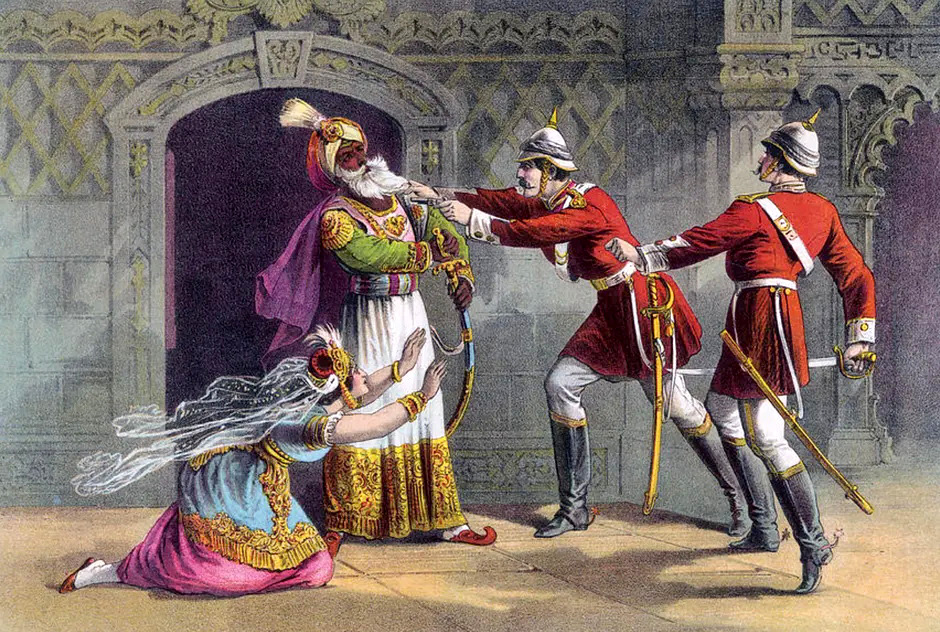
Even though in history textbooks the British were often assumed to be the successors of the Mughals in India, it is important to note that the British did not in fact take on the Mughals when they were a force to be reckoned with. British rule began when the Mughals’ power had declined, though formally even the nawab of Bengal, whom the British defeated, was their subject. The nawab still swore allegiance to the Mughal emperor, without paying very much attention to his dictates. The imperial status of the Mughal authority over India continued to be widely acknowledged even though the powerful empire itself was missing.
When the so-called sepoy mutiny threatened the foundations of British India in 1857, the diverse anti-British forces participating in the joint rebellion could be aligned through their shared acceptance of the formal legitimacy of the Mughal emperor as the ruler of India. The emperor was, in fact, reluctant to lead the rebels, but this did not stop the rebels from declaring him the emperor of all India. The 82-year-old Mughal monarch, Bahadur Shah II, known as Zafar, was far more interested in reading and writing poetry than in fighting wars or ruling India. He could do little to help the 1,400 unarmed civilians of Delhi whom the British killed as the mutiny was brutally crushed and the city largely destroyed. The poet-emperor was banished to Burma, where he died.
As a child growing up in Burma in the 1930s, I was taken by my parents to see Zafar’s grave in Rangoon, which was close to the famous Shwedagon Pagoda. The grave was not allowed to be anything more than an undistinguished stone slab covered with corrugated iron. I remember discussing with my father how the British rulers of India and Burma must evidently have been afraid of the evocative power of the remains of the last Mughal emperor. The inscription on the grave noted only that “Bahadur Shah was ex-King of Delhi” – no mention of “empire” in the commemoration! It was only much later, in the 1990s, that Zafar would be honoured with something closer to what could decently serve as the grave of the last Mughal emperor.
In the absence of the British Raj, the most likely successors to the Mughals would probably have been the newly emerging Hindu Maratha powers near Bombay, who periodically sacked the Mughal capital of Delhi and exercised their power to intervene across India. Already by 1742, the East India Company had built a huge “Maratha ditch” at the edge of Calcutta to slow down the lightning raids of the Maratha cavalry, which rode rapidly across 1,000 miles or more. But the Marathas were still quite far from putting together anything like the plan of an all-India empire.
The British, by contrast, were not satisfied until they were the dominant power across the bulk of the subcontinent, and in this they were not so much bringing a new vision of a united India from abroad as acting as the successor of previous domestic empires. British rule spread to the rest of the country from its imperial foundations in Calcutta, beginning almost immediately after Plassey. As the company’s power expanded across India, Calcutta became the capital of the newly emerging empire, a position it occupied from the mid-18th century until 1911 (when the capital was moved to Delhi). It was from Calcutta that the conquest of other parts of India was planned and directed. The profits made by the East India Company from its economic operations in Bengal financed, to a great extent, the wars that the British waged across India in the period of their colonial expansion.
What has been called “the financial bleeding of Bengal” began very soon after Plassey. With the nawabs under their control, the company made big money not only from territorial revenues, but also from the unique privilege of duty-free trade in the rich Bengal economy – even without counting the so-called gifts that the Company regularly extracted from local merchants. Those who wish to be inspired by the glory of the British empire would do well to avoid reading Adam Smith’s The Wealth of Nations, including his discussion of the abuse of state power by a “mercantile company which oppresses and domineers in the East Indies”. As the historian William Dalrymple has observed: “The economic figures speak for themselves. In 1600, when the East India Company was founded, Britain was generating 1.8% of the world’s GDP, while India was producing 22.5%. By the peak of the Raj, those figures had more or less been reversed: India was reduced from the world’s leading manufacturing nation to a symbol of famine and deprivation.”
While most of the loot from the financial bleeding accrued to British company officials in Bengal, there was widespread participation by the political and business leadership in Britain: nearly a quarter of the members of parliament in London owned stocks in the East India Company after Plassey. The commercial benefits from Britain’s Indian empire thus reached far into the British establishment.
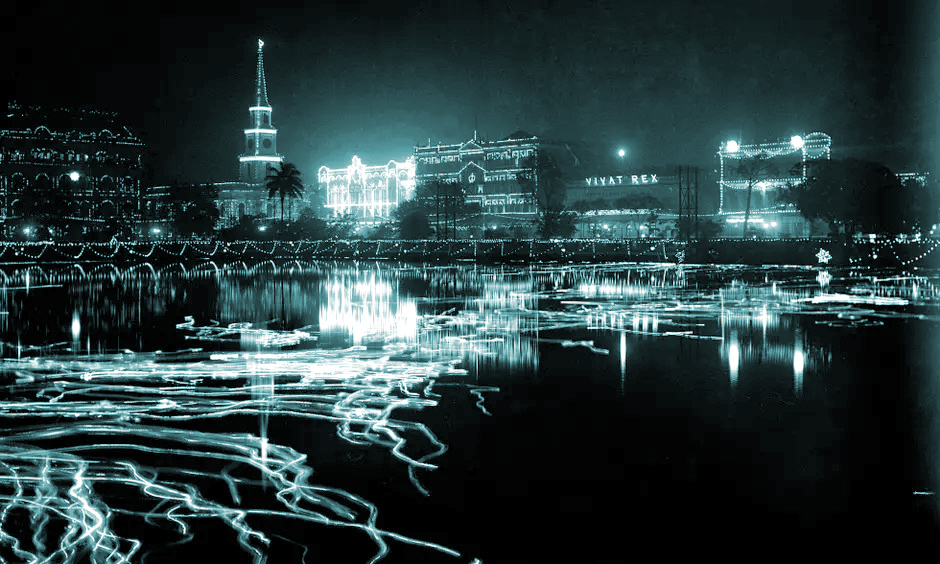
[Photograph: RCAHMS/PA]
The robber-ruler synthesis did eventually give way to what would eventually become classical colonialism, with the recognition of the need for law and order and a modicum of reasonable governance. But the early misuse of state power by the East India Company put the economy of Bengal under huge stress. What the cartographer John Thornton, in his famous chart of the region in 1703, had described as “the Rich Kingdom of Bengal” experienced a gigantic famine during 1769–70. Contemporary estimates suggested that about a third of the Bengal population died. This is almost certainly an overestimate. There was no doubt, however, that it was a huge catastrophe, with massive starvation and mortality – in a region that had seen no famine for a very long time.
This disaster had at least two significant effects. First, the inequity of early British rule in India became the subject of considerable political criticism in Britain itself. By the time Adam Smith roundly declared in The Wealth of Nations that the East India Company was “altogether unfit to govern its territorial possessions”, there were many British figures, such as Edmund Burke, making similar critiques. Second, the economic decline of Bengal did eventually ruin the company’s business as well, hurting British investors themselves, and giving the powers in London reason to change their business in India into more of a regular state-run operation.
By the late 18th century, the period of so-called “post-Plassey plunder”, with which British rule in India began, was giving way to the sort of colonial subjugation that would soon become the imperial standard, and with which the subcontinent would become more and more familiar in the following century and a half.
How successful was this long phase of classical imperialism in British India, which lasted from the late 18th century until independence in 1947? The British claimed a huge set of achievements, including democracy, the rule of law, railways, the joint stock company and cricket, but the gap between theory and practice – with the exception of cricket – remained wide throughout the history of imperial relations between the two countries. Putting the tally together in the years of pre-independence assessment, it was easy to see how far short the achievements were compared with the rhetoric of accomplishment.
Indeed, Rudyard Kipling caught the self-congratulatory note of the British imperial administrator admirably well in his famous poem on imperialism:
Take up the White Man’s burden –
Fill full the mouth of famine
The savage wars of peace –
And bid the sickness cease
Alas, neither the stopping of famines nor the remedying of ill health was part of the high-performance achievements of British rule in India. Nothing could lead us away from the fact that life expectancy at birth in India as the empire ended was abysmally low: 32 years, at most.
The abstemiousness of colonial rule in neglecting basic education reflects the view taken by the dominant administrators of the needs of the subject nation. There was a huge asymmetry between the ruler and the ruled. The British government became increasingly determined in the 19th century to achieve universal literacy for the native British population. In contrast, the literacy rates in India under the Raj were very low. When the empire ended, the adult literacy rate in India was barely 15%. The only regions in India with comparatively high literacy were the “native kingdoms” of Travancore and Cochin (formally outside the British empire), which, since independence, have constituted the bulk of the state of Kerala. These kingdoms, though dependent on the British administration for foreign policy and defence, had remained technically outside the empire and had considerable freedom in domestic policy, which they exercised in favour of more school education and public health care.
The 200 years of colonial rule were also a period of massive economic stagnation, with hardly any advance at all in real GNP per capita. These grim facts were much aired after independence in the newly liberated media, whose rich culture was in part – it must be acknowledged – an inheritance from British civil society. Even though the Indian media was very often muzzled during the Raj – mostly to prohibit criticism of imperial rule, for example at the time of the Bengal famine of 1943 – the tradition of a free press, carefully cultivated in Britain, provided a good model for India to follow as the country achieved independence.
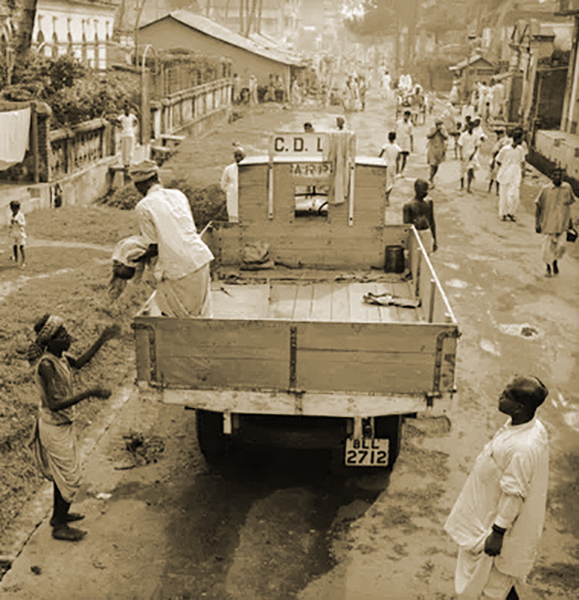
Indeed, India received many constructive things from Britain that did not – could not – come into their own until after independence. Literature in the Indian languages took some inspiration and borrowed genres from English literature, including the flourishing tradition of writing in English. Under the Raj, there were restrictions on what could be published and propagated (even some of Tagore’s books were banned). These days the government of India has no such need, but alas – for altogether different reasons of domestic politics – the restrictions are sometimes no less intrusive than during the colonial rule.
Nothing is perhaps as important in this respect as the functioning of a multiparty democracy and a free press. But often enough these were not gifts that could be exercised under the British administration during imperial days. They became realisable only when the British left – they were the fruits of learning from Britain’s own experience, which India could use freely only after the period of empire had ended. Imperial rule tends to require some degree of tyranny: asymmetrical power is not usually associated with a free press or with a vote-counting democracy, since neither of them is compatible with the need to keep colonial subjects in check.
Asimilar scepticism is appropriate about the British claim that they had eliminated famine in dependent territories such as India. British governance of India began with the famine of 1769-70, and there were regular famines in India throughout the duration of British rule. The Raj also ended with the terrible famine of 1943. In contrast, there has been no famine in India since independence in 1947.
The irony again is that the institutions that ended famines in independent India – democracy and an independent media – came directly from Britain. The connection between these institutions and famine prevention is simple to understand. Famines are easy to prevent, since the distribution of a comparatively small amount of free food, or the offering of some public employment at comparatively modest wages (which gives the beneficiaries the ability to buy food), allows those threatened by famine the ability to escape extreme hunger. So any government should be able stop a threatening famine – large or small – and it is very much in the interest of a government in a functioning democracy, facing a free press, to do so. A free press makes the facts of a developing famine known to all, and a democratic vote makes it hard to win elections during – or after – a famine, hence giving a government the additional incentive to tackle the issue without delay.
India did not have this freedom from famine for as long as its people were without their democratic rights, even though it was being ruled by the foremost democracy in the world, with a famously free press in the metropolis – but not in the colonies. These freedom-oriented institutions were for the rulers but not for the imperial subjects.
In the powerful indictment of British rule in India that Tagore presented in 1941, he argued that India had gained a great deal from its association with Britain, for example, from “discussions centred upon Shakespeare’s drama and Byron’s poetry and above all … the large-hearted liberalism of 19th-century English politics”. The tragedy, he said, came from the fact that what “was truly best in their own civilisation, the upholding of dignity of human relationships, has no place in the British administration of this country”. Indeed, the British could not have allowed Indian subjects to avail themselves of these freedoms without threatening the empire itself.
The distinction between the role of Britain and that of British imperialism could not have been clearer. As the union jack was being lowered across India, it was a distinction of which we were profoundly aware.
Adapted from Home in the World: A Memoir by Amartya Sen, published by Allen Lane on 8 July and available at guardianbookshop.com
- පැරණිතම බුදුසිරිත හෙළිදරව් කරන අලුත් පොතක්.. - June 6, 2025
- මේක ඩොලර් නිසා පිස්සු වැටුණු ආණ්ඩුවක්.. - June 2, 2025
- ට්රම්ප්ගේ තීරු බද්දෙන්ලංකාව වැටෙයි ද ? - April 11, 2025

